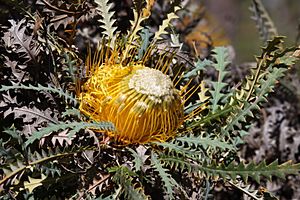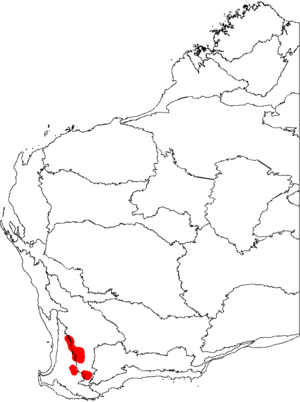Banksia stuposa facts for kids
Quick facts for kids Banksia stuposa |
|
|---|---|
 |
|
| At Boyagin Rock Nature Reserve | |
| Scientific classification | |
| Genus: |
Banksia
|
| Species: |
stuposa
|
| Synonyms | |
|
|
Banksia stuposa is a type of shrub found only in the southwest part of Western Australia. It has stems covered in fine hairs. Its leaves are long and divided into many small parts. This plant produces beautiful golden yellow and white flowers. These flowers grow in large clusters, with over a hundred flowers in each head. After flowering, it forms hairy, egg-shaped fruits called follicles.
What it Looks Like
Banksia stuposa grows as a shrub and can reach up to 3 meters (about 10 feet) tall. It does not form a special underground stem called a lignotuber. Its leaves are tough and have a bluish color. They are about 5 to 15 centimeters (2 to 6 inches) long and 7 to 14 millimeters (about half an inch) wide. Each leaf has many small, triangular sections along its edges, usually between fifteen and thirty on each side.
The flowers are a mix of golden yellow and white. They grow in large, round clusters at the end of branches or on short side branches. Each cluster can have between 100 and 130 flowers. At the base of these flower heads, there are special leaf-like parts called bracts. These bracts are covered in silky hairs. The flowers bloom for a long time, from January to May or from July to December. After the flowers fade, they form egg-shaped fruits that are about 9 to 11 millimeters long.
How it Got its Name
This plant was first described in 1840 by a botanist named John Lindley. He gave it the name Dryandra stuposa. The specimens he studied were collected by James Drummond, another botanist.
The name stuposa comes from a Latin word, stupposus. This word means "covered with coarse, matted hairs." This refers to the silky, woolly hairs found on the bracts at the base of the flower heads. Lindley might have made a small spelling mistake by dropping a 'p' from the original Latin word.
For a while, some people spelled the name as Dryandra stupposa to correct this. However, the original spelling, stuposa, is now used again. In 2007, scientists Austin Mast and Kevin Thiele moved all Dryandra species, including this one, into the larger Banksia group. So, its official scientific name became Banksia stuposa. Its closest plant relative is the golden dryandra (Banksia nobilis).
Where it Lives
Banksia stuposa is found in a specific area of Western Australia. It grows between the towns of York and Broomehill. This plant prefers to grow in soils that are rich in laterite. You can often find it in areas with mallee-kwongan (a type of shrubland) or eucalypt woodlands.
Growing This Plant
Even though Banksia stuposa has large, attractive yellow flowers, it is not grown very often in gardens. If you want to grow it, it needs soil that drains water well. It also likes a lot of sunshine, but it can handle some shade.
This plant is quite tough. It can survive dry periods and can handle frost down to about -7°C (19°F). It also responds well if you prune it. In gardens, it usually doesn't grow as tall as it does in the wild, often staying under 2 meters (about 6.5 feet) high. It also tends to be short-lived when cultivated. You can grow new plants from seeds. The seeds usually sprout in about six weeks, and about 70% of them will grow successfully.


